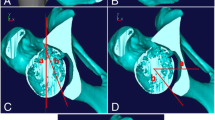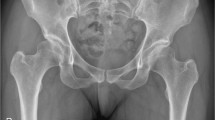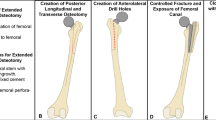Abstract
Purpose
Curved peri-acetabular osteotomy (CPO) produces excellent clinical results, but the surgical procedure is technically demanding, and severe complications related to the osteotomy have been reported. To provide a safe, accurate surgical procedure, we have developed a novel method for setting the cutting line and direction. We have designed and made a custom cutting guide for individual patients. The purpose of the study was to evaluate the efficacy of this new method and cutting guide.
Methods
The cutting line was designed on a full-scale three-dimensional plaster model made from computed tomography (CT) data for each case. The surface of each plaster model was colour-coded according to the distance from the centre of the femoral head. A custom cutting guide was designed based on this cutting line on the workstation. A titanium custom cutting guide was fabricated using rapid prototyping technology. The cutting guide directed the cutting direction of the osteotome. We evaluated the outcomes for seven consecutive hips in seven patients who underwent CPO using the system between April and December 2011. All peri-operative complications were recorded. The accuracy of the cutting line was evaluated using CT data obtained two weeks after the operation.
Results
There were no major complications related to the osteotomy such as posterior column fracture or intra-articular osteotomy. The actual cutting line corresponded almost exactly to the planned cutting line in all cases.
Conclusions
The colour-coded plaster model and the custom cutting guide were effective for avoiding severe complications associated with a CPO.





Similar content being viewed by others

References
Murphy SB, Ganz R, Müller ME (1995) The prognosis in untreated dysplasia of the hip. A study of radiographic factors that predict the outcome. J Bone Joint Surg Am 77(7):985–989
Poss R (1984) The role of osteotomy in the treatment of osteoarthritis of the hip. J Bone Joint Surg Am 66(1):144–151
Wagner H (1976) Osteotomy for congenital hip dislocation. In: Proceedings of the fourth scientific meeting of the Hip Society. Mosby, St. Louis, pp 45–66
Eppright RH (1975) Dial osteotomy of the acetabulum in the treatment of dysplasia of the hip. J Bone Joint Surg Am 57(8):1172
Ninomiya S, Tagawa H (1984) Rotational acetabular osteotomy for the dysplastic hip. J Bone Joint Surg Am 66(3):430–436
Ko JY, Wang CJ, Lin CF, Shih CH (2002) Periacetabular osteotomy through a modified ollier transtrochanteric approach for treatment of painful dysplastic hips. J Bone Joint Surg Am 84-A(9):1594–1604
Nozawa M, Shitoto K, Matsuda K, Maezawa K, Kurosawa H (2002) Rotational acetabular osteotomy for acetabular dysplasia. A follow-up for more than ten years. J Bone Joint Surg Br 84(1):59–65
Ito H, Matsuno T, Minami A (2007) Rotational acetabular osteotomy through an ollier lateral u approach. Clin Orthop Relat Res 459:200–206. doi:10.1097/BLO.0b013e31803b942a
Hussell JG, Mast JW, Mayo KA, Howie DW, Ganz R (1999) A comparison of different surgical approaches for the periacetabular osteotomy. Clin Orthop Relat Res 363:64–72
Ganz R, Klaue K, Vinh TS, Mast JW (1988) A new periacetabular osteotomy for the treatment of hip dysplasias. Technique and preliminary results. Clin Orthop Relat Res 232:26–36
Steppacher SD, Tannast M, Ganz R, Siebenrock KA (2008) Mean 20-year followup of Bernese periacetabular osteotomy. Clin Orthop Relat Res 466(7):1633–1644. doi:10.1007/s11999-008-0242-3
Matheney T, Kim YJ, Zurakowski D, Matero C, Millis M (2010) Intermediate to long-term results following the bernese periacetabular osteotomy and predictors of clinical outcome: surgical technique. J Bone Joint Surg Am 92(Suppl 1 Pt 2):115–129. doi:10.2106/JBJS.J.00646
Hartig-Andreasen C, Troelsen A, Thillemann TM, Søballe K (2012) What factors predict failure 4 to 12 years after periacetabular osteotomy? Clin Orthop Relat Res 470(11):2978–2987. doi:10.1007/s11999-012-2386-4
Zhu J, Chen X, Cui Y, Shen C, Cai G (2013) Mid-term results of Bernese periacetabular osteotomy for developmental dysplasia of hip in middle aged patients. Int Orthop. doi:10.1007/s00264-013-1790-z
Shiramizu K, Naito M, Asayama I, Yatsunami M (2003) Curved periacetabular osteotomy for the dysplastic hip: cadaveric and radiological analyses of safe procedures. J Orthop Traumatol 4:55–60
Naito M, Shiramizu K, Akiyoshi Y, Ezoe M, Nakamura Y (2005) Curved periacetabular osteotomy for treatment of dysplastic hip. Clin Orthop Relat Res 433:129–135
Hussell JG, Rodriguez JA, Ganz R (1999) Technical complications of the Bernese periacetabular osteotomy. Clin Orthop Relat Res 363:81–92
Davey JP, Santore RF (1999) Complications of periacetabular osteotomy. Clin Orthop Relat Res 363:33–37
Akiyama H, Goto K, So K, Nakamura T (2010) Computed tomography-based navigation for curved periacetabular osteotomy. J Orthop Sci 15(6):829–833
Hsieh PH, Chang YH, Shih CH (2006) Image-guided periacetabular osteotomy: computer-assisted navigation compared with the conventional technique: a randomized study of 36 patients followed for 2 years. Acta Orthop 77(4):591–597. doi:10.1080/17453670610012656
Crowe JF, Mani VJ, Ranawat CS (1979) Total hip replacement in congenital dislocation and dysplasia of the hip. J Bone Joint Surg Am 61(1):15–23
Tönnis D, Heinecke A (1999) Acetabular and femoral anteversion: relationship with osteoarthritis of the hip. J Bone Joint Surg Am 81(12):1747–1770
Ezoe M, Naito M, Asayama I (2006) Muscle strength improves after abductor-sparing periacetabular osteotomy. Clin Orthop Relat Res 444:161–168
Shiramizu K, Naito M, Asayama I, Yatsunami M (2004) A quantitative anatomic characterization of the quadrilateral surface for periacetabular osteotomy. Clin Orthop Relat Res 418:157–161
Conflict of interest
The authors declare that they have no conflict of interest.
Author information
Authors and Affiliations
Corresponding author
Additional information
Bungo Otsuki and Mitsuru Takemoto contributed equally to this work.
Rights and permissions
About this article
Cite this article
Otsuki, B., Takemoto, M., Kawanabe, K. et al. Developing a novel custom cutting guide for curved peri-acetabular osteotomy. International Orthopaedics (SICOT) 37, 1033–1038 (2013). https://doi.org/10.1007/s00264-013-1873-x
Received:
Accepted:
Published:
Issue Date:
DOI: https://doi.org/10.1007/s00264-013-1873-x



